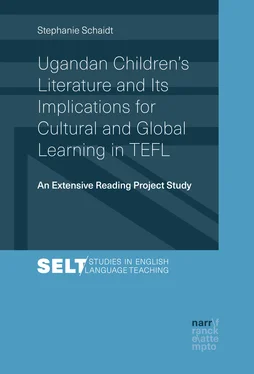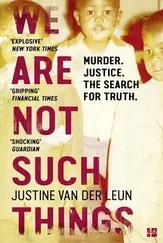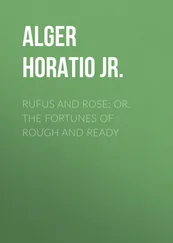‘Well, the moment the inspector left, old Mukibi let it be known that things were going back to normal.’ ‘What do you mean by back to normal?’ ‘Back to what they were before old Mukibi knew his school was going to be inspected. The cooks have been told to return their new uniforms. He’s cancelled the order for goats which he placed with somebody in the village, and he says he’s not buying any more eggs or milk because he has to pay for the tinned stuff that we found and used when it fell off the lorry.’ (Ibid., p. 80)
These passages in the book can be read as reflections upon the insufficiency of the educational system in the country.
According to Oldfield (2013, p. 201), Kimenye wanted “to empower children through the Moses stories”. Moses experiences a lot of injustices at school. In Moses and Moses in Trouble , he is, for example, wrongly accused of lying and having stolen food. He is severely punished by Mr Karanja, the deputy headmaster. The boarding school structure as described in the novels may, therefore, be referred to as oppressive and can even be compared to the colonial system: “Institutions such as the boarding-school system in the Moses books attempt to inhibit and squash autonomy – much as colonialism did (and Mukibi’s school is legacy of such systems of control)” (Oldfield, 2013, p. 202). Through their pranks and tricks, Moses and his friends, however, find ways to transform their own situation; they constantly “transgress boundaries” (Oldfield, 2013).
Since the 1990s, much of the Ugandan children’s fiction in a realistic mode focuses on the topic of HIV/AIDS. There are several narratives that put this topic at the centre of the plot and may, therefore, be referred to as HIV/AIDS narratives; other texts use it as a backdrop.
Uganda was one of the first African countries which reacted to AIDS and it is internationally celebrated as the African AIDS success story. In recent years, HIV rates, which had dropped drastically from 18 % in the early 1990s to 6.4 % in 2005 (Natukunda, 2014), are, however, again on the rise.1
HIV/AIDS is not only a medical issue which can be explained scientifically but it also reaches out far beyond this field: “HIV/AIDS cuts across discourses and involves a variety of aspects such as historical, economic, political, social, psychological, ethical and cultural issues” (Grünkemeier, 2013, p. 10). For people to understand this disease, it needs to be contextualised. This can, for example, be done through fiction. Fiction may be evaluated as particularly effective in the struggle against HIV/AIDS and connected aspects, such as stigma, since it humanises facts and figures. Readers get insights into feelings of people who are infected and affected by the disease and so develop a better understanding of it:
Fiction provides a repertoire of means to communicate what science cannot by providing a prism which puts medical issues on HIV/AIDS in sharper focus. This fiction tells the reader much about the anxieties and uncertainties that HIV/AIDS has wrought on individuals and into society in a way that a purely scientific discourse cannot. The writers make an important contribution to cultural production because their works comment on, and more importantly, offer possibilities of imagining and (re)creating new forms and practices of social and sexual behaviour in society. (Muriungi, 2007, p. 301)
Since HIV/AIDS has been one of the most pressing issues affecting Uganda for more than three decades now, it is not surprising that many writers deal with this topic. Since the 1990s, the different dimensions of AIDS have been explored in Ugandan literature, oral and written. Many Ugandan writers have reflected on the AIDS epidemic in their novels, stories, plays and poems and also songs and a large number of these literary texts are addressed to young people.
Today, HIV/AIDS narratives play a very important role in Uganda in educating young people about the disease. The first children’s narratives dealing with HIV/AIDS were published in the mid-1990s. The number of publications increased when the Ugandan government started to expand HIV prevention education to primary and secondary schools in 2001. Then, international and local publishers commissioned Ugandan writers to write HIV/AIDS narratives which were published in different series. Uganda is now awash with HIV/AIDS stories for children and young adults.
The fact that many of the writers who write about HIV/AIDS are commissioned by international or local publishing houses has an influence on their writing. The writers attend seminars in which they are given advice on about what (not) to write in the books.2 The Ugandan government set regulations that should be followed in HIV/AIDS education (President’s Initiative on HIV/AIDS Strategy on Communication to Youth, PIASCY). Like many religious organisations inside and outside the country, the government does not particularly encourage the use of condoms which may explain the near-absence of references to condoms in HIV/AIDS narratives in Uganda.3
The way HIV/AIDS is dealt with in children's literature has gone through changes in the last decades. Whereas early publications still focus more on shocking issues with the aim of deterrence, newer publications also increasingly take aspects such as living positively into account. This may be related to the development that HIV/AIDS affects society differently today. The Ugandan writer Beatrice Lamwaka states in an interview:
The days of my HIV time were not the same as today’s children’s HIV time. Then people would get skinny, the disease would really affect somebody and you would look at that person and know: Oh, my goodness. But that’s not the situation now. People just live with it today.4
Her novella, Anena’s Victory (2003) that vividly talks about the decaying body and painful death of Anena’s mother of AIDS, is still set in the former times, she explains.
The Ugandan HIV/AIDS narratives deal with topics which are relevant for children in Uganda. They are educative and talk about scientific issues such as the transmission and prevention of HIV/AIDS, but they also address other dimensions of the epidemic: care, stigma and living positively. Peer pressure and sugar mummies/daddies are further themes reoccurring in the books. Besides narratives that focus on HIV/AIDS related topics only, there are various texts that use the HIV/AIDS epidemic as a setback (e.g. Voice of a Dream ).
In many HIV/AIDS narratives, children are presented as victims of circumstances. They either give in to peer pressure and/or the advances of a sugar daddy or mummy, and this finally destroys them. In some of the stories the children manage to get back on the right track and escape the destiny of being infected with HIV but other stories end on quite a sad note. The pretty and intelligent Gwendolyn in The Unfulfilled Dream (Ocwinyo, 2003), for example, gives in her friend’s pleading to escape from school and accompanies her to a bar. There the two girls meet two elder men who buy them drinks. Next, Gwendolyn wakes up in the bed of one of the men. When the headmistress finds out that the two girls have lied to her, they are expelled from school. Soon after Gwendolyn finds out that she is HIV-positive and pregnant. She loses her baby because it is also HIV-positive and she is shunned by the people in her village.
Now when Gwendolyn Akello walks through Teboke trading centre, or goes to market, or to the well, people do not treat her with much respect any more. They do not admire her beauty, or her intelligence any longer. Instead they pity her. Sometimes they even laugh at her. They all know she is sick. They all know she will die soon. They call her the beautiful and brilliant girl who did not know what to do with her great promise. (Ibid., p. 53)
Читать дальше












